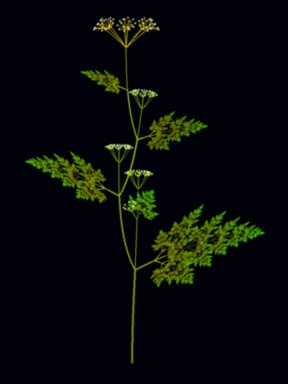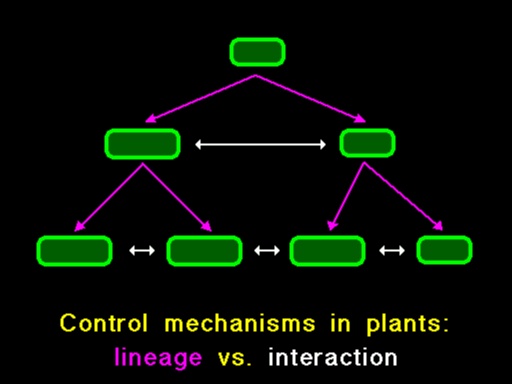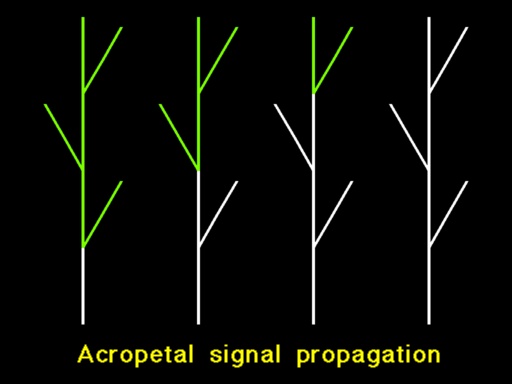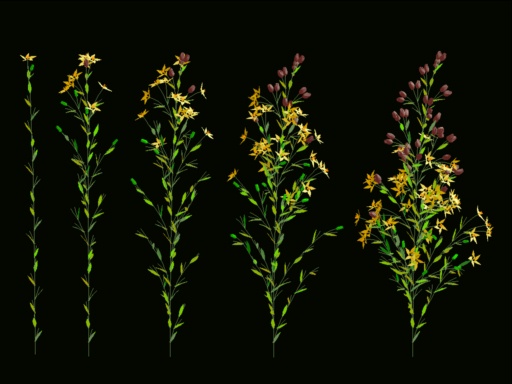|
|
| We might think that we are now able to model all possible
inflorescences, since we have considered all possible branching types. This
is not quite true. |
 One problem is related to the flowering
sequences. For example, in wild carrot, shown in
Plate 21,
flowers first appear at the top of the structure and the flowering zone
progresses basipetally (downwards). As plants develop from the bottom up
and not from the top down, the basipetal flowering sequence is opposite
to the order in which the buds were originally formed.
One problem is related to the flowering
sequences. For example, in wild carrot, shown in
Plate 21,
flowers first appear at the top of the structure and the flowering zone
progresses basipetally (downwards). As plants develop from the bottom up
and not from the top down, the basipetal flowering sequence is opposite
to the order in which the buds were originally formed. |
|
 The mint in
Plate 22
illustrates the same point. Again, the top group of flowers was created
last, yet opens first.
The mint in
Plate 22
illustrates the same point. Again, the top group of flowers was created
last, yet opens first.
In order to capture such processes, it is necessary to
consider various forms of information flow in a developing plant. The L-system
rules outlined in Section
8 represent information transfer by lineage, or from the mother
module to the daughter modules. They are called context-free rules
in formal language (L-system) terminology. In many plants the interaction
between coexisting modules also plays an important role. Such interaction
may have the form of a flow of nutrients, water, or hormones between the
modules of a developing plant. |
|
 The relationship between
information transfer by lineage and interaction is shown schematically in
Plate 23.
A cell (module) divides, producing two new cells that subsequently divide
as well. Information can be transferred by lineage (diagonal arrows) or
by interaction (horizontal arrows).
The relationship between
information transfer by lineage and interaction is shown schematically in
Plate 23.
A cell (module) divides, producing two new cells that subsequently divide
as well. Information can be transferred by lineage (diagonal arrows) or
by interaction (horizontal arrows).
Interactive processes can be captured by context-sensitive
L-systems. In the context-sensitive case, a rule is applied to a particular
module only if this module has some specific neighbors. |
|
 For example, in
Plate 24,
a green module becomes white if and only if there is already a white module
directly below it. Thus, context sensitivity makes it possible to simulate
propagation of a signal.
For example, in
Plate 24,
a green module becomes white if and only if there is already a white module
directly below it. Thus, context sensitivity makes it possible to simulate
propagation of a signal.
The flow of information in a static structure is of some
interest, but even more interesting phenomena occur in growing structures.
For example, consider a flower-inducing signal, corresponding to the hypothetical
hormone florigen, which is sent from the bottom of the growing plant
towards the apices. An apex reached by this signal is transformed into a
flowering bud, then a flower, and finally a fruit. |
|
Depending on the relative growth rates of the main axis
and the lateral branches, and on the respective ratios of signal propagation,
the flowering zone may progress acropetally (upwards) as shown in
Animation 15,
or basipetally (downwards) as shown in
Animation 16.
Animation 17
and
Animation 18
illustrate a basipetal flowering sequence using a schematic and a realistic
model of hawkweed (Hieracium umbellatum). Once the apex of the main
axis has been transformed into a flowering bud, flowers on the lower branches
are formed one after another in a basipetal sequence.
Animation 19
shows a close-up of the development of a single flower from the bud to an
open flower to a fruit.
|
|
Some models may require several signals. This occurs,
in particular, when the flowering sequence progresses from the top down,
and in some stages the plant is more extensively developed near the top
than near the bottom. Mycelis muralis, or wall lettuce, shown schematically
in
Animation 20,
provides an example.
Initially, the apex of the main axis produces a sequence
of lateral branches. At this stage, their further development is inhibited.
At some point in time, florigen is induced near the base of the plant and
propagates upwards. When it reaches the apex of the main axis, the apex
is transformed into a bud, and then a flower. Shortly afterwards, another
signal is sent from the apex and propagates downwards. This signal lifts
the apical dominance, allowing the lateral branches to grow. As this enabling
sequence proceeds from the top down, the top part of the structure can be
more developed that the bottom part. A third signal (not shown in the animation)
introduces florigen into the lateral branches, so that their apices can
be eventually transformed into flowers.

A three-dimensional rendering of this developmental sequence
is shown in
Plate 25
and
Animation 21.
|
|